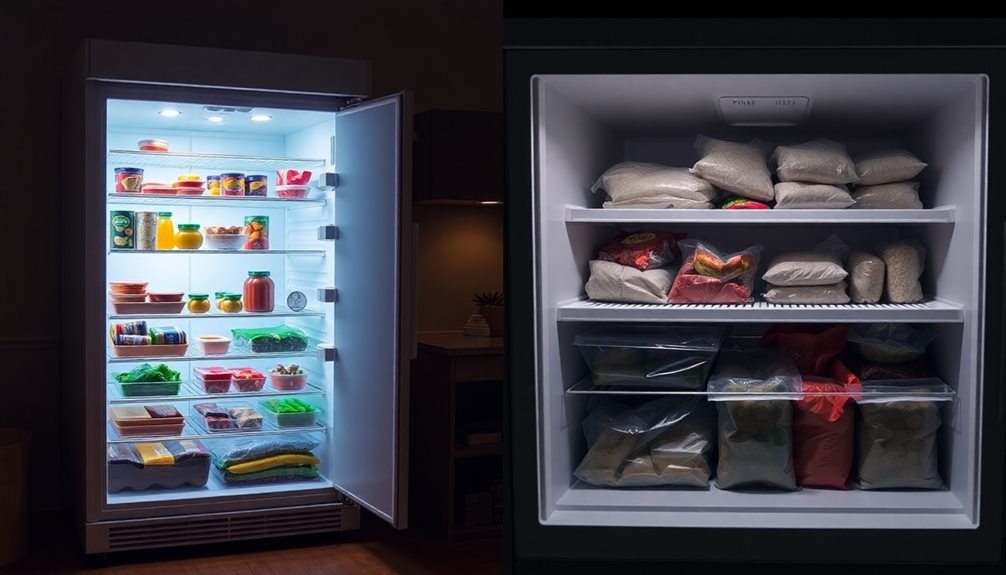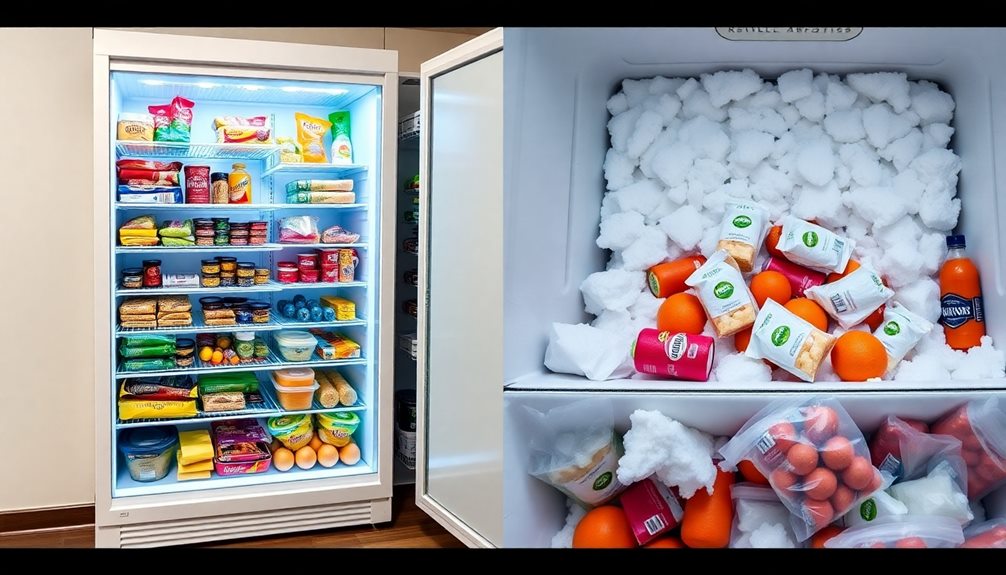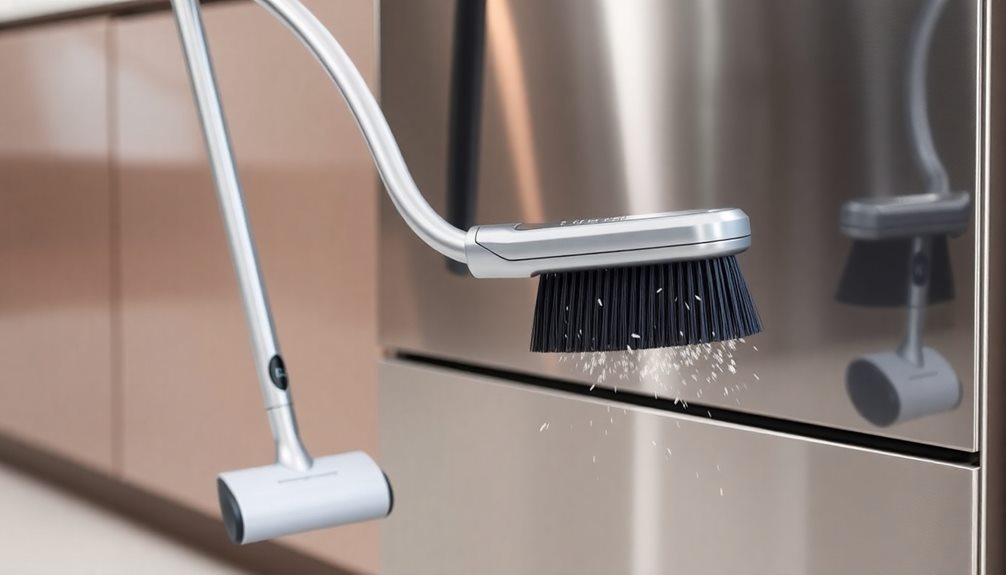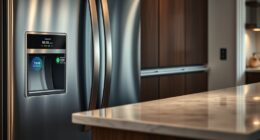When choosing between an upright and a chest freezer, think about your storage needs and space. Chest freezers offer more usable space, better energy efficiency, and can maintain temperatures longer during outages, making them ideal for bulk storage. However, they require more floor space and can be hard to organize. On the other hand, upright freezers are more compact, easier to access, and often come with shelving but can be pricier and less energy-efficient. Your decision should align with your lifestyle and preferences. Keep exploring to uncover more insights on making the right choice for your needs!
Key Takeaways
- Chest freezers are more energy-efficient, leading to lower electricity bills and long-term savings compared to upright freezers.
- Upright freezers occupy less floor space, making them suitable for smaller homes and tighter areas.
- Chest freezers provide about 20% more usable storage space, ideal for families needing bulk storage.
- Upright freezers feature built-in shelves for better organization and easier access to frozen items.
- Consider your family's size and storage needs when choosing a freezer, with 14.8 to 21 cu. ft. recommended for a family of four.
Overview of Freezer Types
When you're deciding between an upright and a chest freezer, it's essential to understand their key differences.
Chest freezers are deep, box-shaped appliances that open from the top, making them perfect for storing large and bulk items. On the other hand, upright freezers resemble refrigerators with front-opening doors and shelves, allowing for easier organization of your frozen goods.
In terms of storage capacity, upright freezers typically range from 3.0 to 25.0 cu. ft., while chest freezers provide a larger capacity with an average of around 16 cu. ft., often reaching up to 25.0 cu. ft.
Pricing-wise, upright freezers generally cost between $600 and $800, while chest freezers are slightly more affordable, ranging from $500 to $700.
When considering floor space, upright freezers occupy less room due to their vertical design, making them suitable for tighter areas.
However, both types of freezers come with their own pros and cons. For instance, chest freezers are more energy-efficient and better at preserving food during power outages, while upright freezers excel in organization and accessibility, helping you find what you need quickly.
Advantages of Chest Freezers

When you consider chest freezers, their energy efficiency and bulk storage capacity stand out.
You'll find that they offer more usable space for your food, making it easier to stock up on groceries.
Plus, the lower energy consumption helps keep your electricity bills in check over time.
Energy Efficiency Benefits
Chest freezers offer impressive energy efficiency benefits that can greatly impact your household expenses.
You'll find that chest freezers typically use about 330 kWh per year, consuming less electricity than upright models, which suffer from increased cold air loss every time the door opens. The tight-fitting lid of a chest freezer minimizes this air loss, allowing it to maintain a consistent internal temperature while keeping your energy costs low.
Additionally, because many coolers aren't completely airtight, the enhanced sealing of chest freezers plays a vital role in their energy efficiency and insulation increased insulation benefits.
When power outages occur, chest freezers can preserve food for up to four days, compared to just two days for upright models. This efficiency not only reduces food waste but also showcases their ability to maintain frozen conditions effectively.
Furthermore, with many chest freezers priced under $600, the initial purchase cost is often lower, making them a budget-friendly choice for energy-conscious consumers.
Ultimately, the energy efficiency of chest freezers contributes to long-term savings on your electricity bills, making them an economical option for bulk food storage.
Choosing a chest freezer means you're investing in a reliable, cost-effective appliance that pays off in both energy savings and food preservation.
Bulk Storage Capacity
Choosing a chest freezer not only enhances energy efficiency but also maximizes your bulk storage capacity. With about 20% more usable storage space compared to upright freezers, chest freezers are perfect for your bulk purchases and larger items. Their design allows for easy stacking, enabling you to store large quantities of food—like whole turkeys or bulk meat—without complex organization.
Here's a quick comparison of storage capabilities:
| Feature | Chest Freezers |
|---|---|
| Usable Storage Space | 20% more than upright freezers |
| Large Item Accommodation | Great for whole turkeys and bulk meat |
| Temperature Consistency | Maintains for up to 4 days during outages |
| Energy Efficiency | Consumes about 330 kWh/year |
The horizontal layout of chest freezers means they fit well in garages or basements without taking up too much vertical space. Plus, they maintain a more consistent temperature, ensuring your food quality remains intact during power outages. If you're looking to store bulk items efficiently, chest freezers are a smart choice.
Disadvantages of Chest Freezers

While chest freezers offer ample storage space, they come with several disadvantages that can impact your experience. One major drawback is that chest freezers require more floor space due to their larger footprint, making them less suitable for smaller areas. This bulkiness can be a challenge if you're trying to maintain an open layout.
Furthermore, accessing food in chest freezers can be inconvenient. You often find yourself bending over to reach items at the bottom, especially when it's full. This makes locating specific items harder to organize, as you might need to rearrange or dig through contents to find what you need.
Additionally, chest freezers tend to be less aesthetically pleasing compared to their upright counterparts. They offer less variety in finishes and designs, which can limit your options if you want your appliance to match your decor.
This lack of style can be a consideration for those who care about the overall look of their space. Overall, while chest freezers have their benefits, these disadvantages are essential to think about before making your choice.
Advantages of Upright Freezers

Upright freezers offer numerous advantages that make them a popular choice for many households. One of the standout features is the built-in shelves and bins, which provide better organization and easier access to your frozen items. You won't have to dig through piles of food anymore; everything will be neatly arranged.
If you're short on space, upright freezers are perfect since they require less floor space, fitting comfortably into smaller homes or apartments.
Many models also come with an auto-defrost feature, which simplifies maintenance by eliminating the hassle of manual defrosting.
Plus, they generally have a lower initial purchase cost, with prices starting around $600-$800 for a 14 cu. ft. model, making them budget-friendly upfront.
Disadvantages of Upright Freezers

When pondering an upright freezer, it's important to weigh its disadvantages. One significant drawback is the initial purchase cost; upright freezers typically range from $600 to $800, which is higher than the cost of chest freezers.
Additionally, upright models are generally less energy-efficient, leading to increased electricity bills as cold air escapes more rapidly each time you open the door.
Another major issue is food preservation during power outages. Upright freezers can only maintain food for about two days, while chest freezers can keep food safe for up to four days.
They also tend to have a shorter lifespan, lasting only 10 to 15 years compared to the 20 years you might expect from chest freezers.
Organization can be a challenge, especially when it comes to larger items; the vertical layout often makes it difficult to store big packages efficiently.
Finally, the design of upright freezers makes them prone to energy loss due to door gaps, further impacting their efficiency.
All of these factors contribute to the disadvantages of an upright, making it essential to evaluate your specific needs before making a decision.
Comparing Energy Efficiency

Energy efficiency is a crucial element to take into account when choosing between upright and chest freezers. Chest freezers are generally more energy-efficient, using about 330 kWh/year, while upright freezers consume more electricity due to greater cold air loss when you open the door.
This design difference can lead to higher operational costs and increased energy bills over time.
One of the standout advantages of chest freezers is their tight-fitting lid, which minimizes cold air loss. This feature allows them to maintain a consistent temperature, preserving food frozen for up to four days during power outages, compared to just two days for upright freezers.
If you want to guarantee better energy use, look for Energy Star ratings when selecting a freezer. You'll often find that chest freezers receive higher ratings for their lower energy consumption.
Size and Capacity Considerations

When choosing a freezer, think about your family's size and your storage needs.
If you often buy in bulk, a chest freezer might offer the space you need, while an upright freezer could be better for tighter areas.
Ideal Family Sizes
Choosing the right freezer size for your family can make a significant difference in your food storage efficiency. For a family of four, a freezer size between 14.8 to 21 cu. ft. is generally recommended. This range guarantees you have enough freezer space to meet your needs without overwhelming your kitchen.
If you live in a smaller space, an upright freezer is often a better fit, providing easier access to your food items and better organization options for smaller items.
On the other hand, if you're looking for ideal bulk storage, a chest freezer might be the way to go due to its larger storage capacity, allowing you to accommodate bigger items.
Remember that each family member typically requires about 2.5 cu. ft. of freezer space, adding up to roughly 10 cu. ft. for a family of four. A general rule of thumb is that 1 cu. ft. can hold around 25 to 35 lbs. of frozen food, helping you plan your storage needs effectively.
Ultimately, choosing the right freezer size will enhance your storage space and streamline your food organization.
Bulk Storage Needs
Considering your bulk storage needs is essential when selecting a freezer, as the right size and capacity can greatly impact your food organization and accessibility.
If you're looking to store large quantities of frozen foods, a chest freezer is likely your best bet. They provide about 20% more usable space compared to upright freezers, making them ideal for bulk storage of larger items. For a family of four, a chest freezer with a capacity of 14.8 to 21 cu. ft. is recommended to adequately accommodate bulk purchases and long-term storage needs.
Upright freezers, on the other hand, range in capacity from 3.0 to 25.0 cu. ft. While they occupy less floor space due to their vertical design, they may limit the amount of bulk items you can store.
Generally, 1 cu. ft. of freezer space holds about 25-35 lbs. of food, so it's vital to calculate your required capacity based on your family size and storage needs.
Ultimately, balancing floor space with storage capacity will help you choose the right freezer for your bulk storage needs.
Making the Right Choice

Making the right choice between an upright and chest freezer can greatly impact your home organization and food storage efficiency.
When considering upright freezers vs. chest freezers, think about your available space and how you plan to organize your frozen items. If you have limited floor space, an upright model could be ideal since it typically occupies less room and features built-in shelves for easy access.
On the other hand, chest freezers generally provide about 20% more usable space and are more energy-efficient, making them a solid option for bulk storage and long-term food preservation. For a family of four, aim for a freezer size of approximately 14.8 to 21 cu. ft. If you often buy large quantities or bulk items, a chest freezer's horizontal layout allows for better accommodation.
While upright freezers often come with a higher price tag, ranging from $600 to $800, chest freezers start at around $500, making them more budget-friendly.
Plus, chest freezers typically last longer, up to 20 years, which can make them a better long-term investment. Consider these factors carefully to make the best choice for your needs.
Frequently Asked Questions
Which Is Better, an Upright Freezer or a Chest Freezer?
Choosing between an upright or chest freezer depends on your needs. If you value accessibility and organization, an upright's shelves work well. For energy efficiency and bulk storage, a chest freezer's capacity is better suited.
What Are the Disadvantages of a Chest Freezer?
Like digging through a treasure chest, accessing food in a chest freezer can be frustrating. It takes more floor space, requires bending down, and visibility is poor, making organization essential to avoid food loss.
Which Brand of Upright Freezer Is the Most Reliable?
When choosing an upright freezer, you'll find Maytag often tops reliability rankings. Brands like Frigidaire, Whirlpool, and GE also earn high marks for performance. Look for Energy Star ratings and solid warranties to guarantee longevity.
Which Type of Freezer Is Best?
You might think picking a freezer is as easy as choosing ice cream flavors, but it's not! Consider your storage needs, space, and energy efficiency. Chest freezers usually offer more space, while uprights excel in organization.
Conclusion
When choosing between an upright and a chest freezer, consider your needs, space, and lifestyle. If you value easy access and organization, an upright might be your best bet. If you need more storage and energy efficiency, a chest freezer could be the way to go. Ultimately, it's about finding the right fit for your home and habits. So, weigh the pros and cons, assess your priorities, and make the choice that suits you best.










